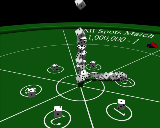


Collision intensive and multi-body simulations are difficult to constrain because they exhibit extreme sensitivity to initial conditions or other simulation parameters, which has restricted their use in applications. For instance, a feature film might require a scene in which dice are shown on a table, only to be knocked onto the floor to come up showing snake eyes in a specific location (an example due to Barzel, Hughes and Wood).
We have developed a methodology for solving such problems that begins by adding plausible sources of uncertainty to the model to be constrained. A probability distribution is then defined for the model which assigns higher probability to desirable animations that are physically plausible, and low probability to unsatisfactory animations or those that are unlikely in the world. A Markov chain Monte Carlo (MCMC) algorithm may then be used to sample animations according to the distribution. Other benefits come from this approach:
We have demonstrated this technique with many examples of collision intensive multi-body simulations that may be constrained to give a specific outcome. No other technique has been described that can handle such difficult systems and hard to satisfy constraints.
Stephen Chenney and D.A.Forsyth, "Sampling Plausible Solutions to Multi-Body Constraint Problems". SIGGRAPH 2000 Conference Proceedings, pages 219-228, July 2000.